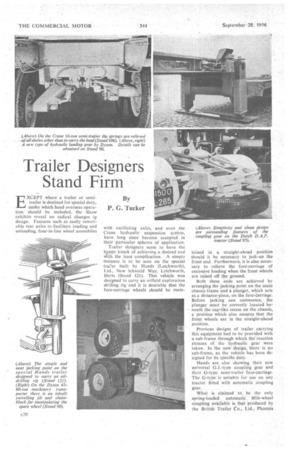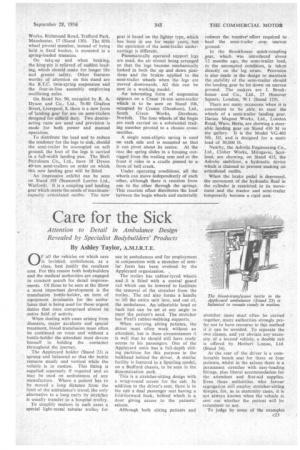Trailer Designers Stand Firm
Page 110

Page 113

If you've noticed an error in this article please click here to report it so we can fix it.
By P. G. Tucker
EXCEPT where 4 trailer or semitrailer is destined for special duty, under which head overseas operaton should be included, the Show exhibits reveal no radical changes ip design. Features such as easily removable rear axles to facilitate loading and unloading, four-in-line wheel assemblies
with oscillating axles, and even the Crane hydraulic suspension system, have long since become accepted in their particular spheres of application.
Trailer designers seem to have the happy knack of achieving a desired end v/ith the least complication. A simple instance is to be seen on the special trailer built by Hands (Letchworth), Ltd., New Icknield Way, Letchworth, Herts (Stand 121). This vehicle was designed to carry an oilfield exploration drilling rig and it is desirable that the fore-carriage wheels should be main tamed in a straight-ahead position should it be necessary to jack-up the front end. Furthermore, it is also necessary to relieve the fore-carriage of excessive loading when the front wheels are raised off the ground.
Both these ends are achieved by arranging the jacking point on the main chassis frame arid a plunger, which acts as a distance-piece, on the fore-carriage. Before jacking can commence, the plunger must be correctly located beneath the cup-like recess OD the chassis, a position which also ensures that the front wheels are in the straight-ahead position.
Previous designs of trailer carrying this equipment had to be provided with a sub-frame through which the reaction stresses of the hydraulic gear were taken. In the new design, there is no sub-frame, as the vehicle has been de signed for its specific duty. • Hands are also showing their new universal G.J.-type coupling_ gear and their 0-type semi-trailer fore-carriage. The 0-type is suitable for use on any tractor fitted with automatic coupling gear.
What is claimed to be the only spring-loaded automatic. fifth-wheel coupling avhilable is that produced by the British Trailer Co., Ltd.,. Phoenix
Works, Richmond Road, Trafford Park. Manchester, 17 (Stand 130). The fifth wheel pivotal member, instead of being held in fixed bushes, is mounted in a spring-loaded trunnion.
On take-up and when braking, the king-pin is relieved of sudden loading, which should make for longer life and greater safety. Other features worthy of attention on this stand are the B.T.G. twin-spring suspension and the four-in-line assembly employing oscillating axles.
On Stand No. 90, occupied by R. A. Dyson and Co., Ltd., 76-80 Grafton Street, Liverpool, 8, there is a new form of landing gear for use on semi-trailers designed for oilfield duty. Two doubleacting rams are used and provision is made for both power and manual operation.
To distribute the load and to reduce the tendency for the legs to sink, should the semi-trailer be uncoupled on soft ground, the foot of the legs is carried in a full-width landing pan. The Shell Petroleum Co., Ltd., have 18 •Dyson 40-ton semi-trailers on order on which this new landing gear will be fitted.
An impressive exhibit can be seen on Stand 101 (Scammell Lorries Ltd., Watford). It is a coupling and landing gear which meets the needs of maximumcapacity articulated outfits. The new
gear is based on the lighter type, which has been in use for many years, but the operation of the 'semi-trailer undercarriage is different.
Pneumatically operated support legs are used, the air circuit being arranged so that the legs become mechanically locked in both the up and down Positions and the brakes applied to the semi-trailer wheels when the legs are moved downwards. All this can be seen in a working model.
An interesting form of suspension appears on a Crane 16-ton semi-trailer which is to be seen on Stand 106, occupied by Cranes (Dereham), Ltd., South Green Works, Dereham, Norfolk. The four wheels of the bogie are each carried on a substantial trailing member pivoted to a chassis crossmember.
A single semi-elliptic spring is used on each side and is mounted so that it can pivot about its centre. At the rear the spring slides in a housing outrigged from the trailing arm and at the front it rides in a .cradle pinned to a form of bell crank.
Under operating conditions, all the wheels can move independently of each other, although there is reaction from one to the other through the springs. This reaction effect distributes the load between the bogie wheels and materially
reduces the tractive effort required to haul the semi-trailer ovilr uneven ground.
In the Brockhouse quick-coupling gear, which was introduced about 12 months ago, the semi-trailer load, in the uncoupled condition, is taken directly on the leg struts. Provision is also made in the design to maintain the stability of the semi-trailer should the landing gear be let down on uneven ground. The makers are J. Brockhouse and Co., Ltd., 25 Hanover Square, London, W.1 (Stand 129).
There are many occasions when it is convenient to be able to steer the wheels of a semi-trailer landing gear. Davies Magnet Works, Ltd., London Road, Ware, Herts, are showing a steerable landing gear on Stand 430 M in the gallery. It is the Model VG.405 Mk. 111, and is designed for a static load of 30,000 lb.
Nearby, the Adrolic Engineering Co., Ltd., Clober Works, Milngavie, Scotland, are showing, on Stand 415, the Adrolic stabilizer, a hydraulic device .which is claimed to prevent snaking on articulated outfits.
When the brake pedal is depressed, the movement of the hydraulic fluid in the cylinder is restricted in its movement and the tractor and semi-trailer temporarily become a rigid unit.




































































































































































